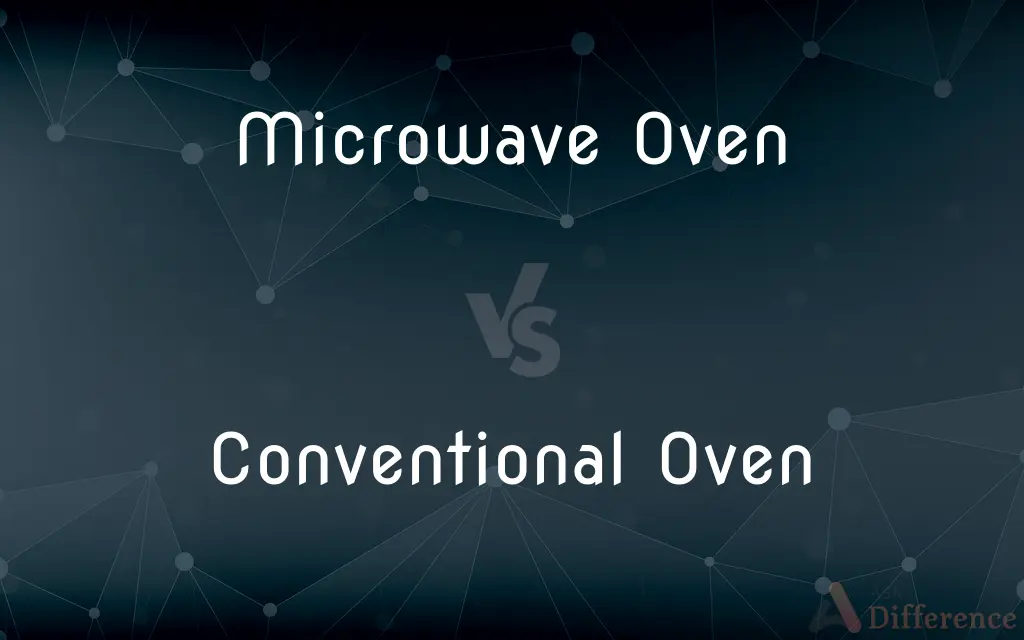Microwave Oven vs. Conventional Oven — What's the Difference?
By Tayyaba Rehman & Fiza Rafique — Published on February 1, 2024
Microwave ovens use microwaves for rapid heating and defrosting, while conventional ovens use heating elements, making them ideal for baking and roasting.

Difference Between Microwave Oven and Conventional Oven
Table of Contents
ADVERTISEMENT
Key Differences
A Microwave Oven utilizes microwave radiation to heat and cook food rapidly, making it ideal for quick heating or defrosting. In contrast, a Conventional Oven uses electric or gas heating elements for cooking, excelling in baking, roasting, and evenly cooking food.
The Microwave Oven's speed and efficiency in heating make it a popular choice for reheating leftovers or cooking ready meals. Conversely, a Conventional Oven is preferred for recipes requiring precise temperature control and even heat distribution, like baking bread or roasting meats.
Microwave Ovens often lack the capability to brown or crisp food, a limitation in certain cooking styles. On the other hand, Conventional Ovens can achieve a wide range of cooking textures and finishes, from crispy crusts to tender roasts.
In terms of energy efficiency, Microwave Ovens generally consume less energy due to their faster cooking times. Conventional Ovens, while more energy-intensive, offer greater versatility in cooking methods and temperatures.
The compact size of many Microwave Ovens makes them suitable for smaller kitchens or as an additional cooking appliance. Conventional Ovens, typically larger, serve as a primary cooking appliance in most households, capable of handling larger dishes and quantities.
ADVERTISEMENT
Comparison Chart
Heating Method
Uses microwave radiation
Uses electric or gas heating elements
Cooking Speed
Quick heating and cooking
Slower, more even cooking
Texture Capabilities
Limited browning/crisping
Excellent for browning, crisping
Energy Efficiency
Generally more energy-efficient
More energy-intensive
Size and Placement
Compact, versatile placement
Larger, typically built-in or freestanding
Temperature Control
Less precise temperature control
Precise temperature settings
Cooking Versatility
Best for reheating and simple cooking
Suitable for a wide range of cooking methods
Food Quantity
Ideal for small to medium portions
Can accommodate larger dishes and quantities
Maintenance
Easy to clean, fewer parts
Requires regular cleaning, more components
Ideal Usage
Quick meals, reheating, defrosting
Baking, roasting, complex recipes
Compare with Definitions
Microwave Oven
Not suitable for baking or browning, as it lacks a heating element.
Making a cake in a Microwave Oven isn't recommended due to its cooking method.
Conventional Oven
Ideal for baking, roasting, and cooking with precise temperature control.
The turkey roasted perfectly in the Conventional Oven.
Microwave Oven
Commonly used for reheating leftovers and ready-to-eat meals.
I often use the Microwave Oven to quickly heat up my lunch.
Conventional Oven
Larger in size, suitable for cooking meals for families or gatherings.
We used the Conventional Oven to cook several dishes for the party.
Microwave Oven
Efficient in energy use and space, ideal for small kitchens.
Our small apartment kitchen is perfect for a Microwave Oven.
Conventional Oven
An oven that cooks food using heated elements, either electric or gas.
I baked a batch of cookies in the Conventional Oven this afternoon.
Microwave Oven
Features quick defrosting capabilities, useful for frozen foods.
I defrosted chicken in the Microwave Oven for dinner tonight.
Conventional Oven
Capable of browning and crisping food, unlike microwave ovens.
The Conventional Oven gave the lasagna a delicious crispy top.
Microwave Oven
A kitchen appliance using microwaves to heat and cook food quickly.
I used the Microwave Oven to reheat my pizza in just two minutes.
Conventional Oven
An oven commonly found in households for various cooking methods.
I prefer using the conventional oven for making homemade lasagna.
Conventional Oven
A kitchen appliance that provides consistent and controlled heat for cooking and baking.
The recipe recommends preheating the conventional oven to 350°F.
Common Curiosities
What types of food are best cooked in a conventional oven?
Conventional ovens are ideal for baking bread, cakes, roasting meats, and cooking dishes that require even heat distribution.
Can you bake in a microwave oven?
Microwave ovens are not suitable for baking in the traditional sense; they are primarily used for heating and reheating food.
What is a microwave oven?
A microwave oven is a kitchen appliance that uses microwaves to quickly heat and cook food.
Are microwave ovens and conventional ovens interchangeable for cooking?
No, microwave ovens and conventional ovens serve different cooking purposes and are not interchangeable.
Can you defrost food in a conventional oven?
It is not recommended to defrost food in a conventional oven; it is safer to use a microwave or the refrigerator for thawing.
Can you use microwave-safe containers in a conventional oven?
No, microwave-safe containers are not suitable for use in a conventional oven, as they may not withstand the higher temperatures.
Do conventional ovens require preheating before cooking?
Yes, preheating a conventional oven to the desired temperature is recommended for consistent cooking results.
How does a microwave oven work?
Microwave ovens work by emitting microwaves that excite water molecules in food, generating heat through friction.
What is a conventional oven?
A conventional oven is a kitchen appliance that uses heating elements to cook food through convection and radiant heat.
What are the main differences between a microwave oven and a conventional oven?
Microwave ovens use microwaves for quick heating, while conventional ovens use heating elements for baking, roasting, and cooking with radiant heat.
Which oven is more energy-efficient, microwave, or conventional?
Microwaves are generally more energy-efficient for heating small portions, while conventional ovens are efficient for larger cooking tasks.
Are microwave ovens faster than conventional ovens?
Microwave ovens are typically faster for heating, but conventional ovens are necessary for baking and roasting.
Can you use metal cookware in a microwave oven?
No, metal should never be used in a microwave oven, but it is safe to use metal cookware in a conventional oven.
What factors should I consider when choosing between a microwave oven and a conventional oven for cooking?
Consider the type of food you regularly prepare, cooking time, and convenience when deciding between a microwave oven and a conventional oven.
Are there convection microwave ovens that combine both cooking methods?
Yes, some microwave ovens have convection settings that allow them to function as mini-conventional ovens.
Share Your Discovery

Previous Comparison
Full Virtualization vs. Paravirtualization
Next Comparison
Mist vs. DewAuthor Spotlight
Written by
Tayyaba RehmanTayyaba Rehman is a distinguished writer, currently serving as a primary contributor to askdifference.com. As a researcher in semantics and etymology, Tayyaba's passion for the complexity of languages and their distinctions has found a perfect home on the platform. Tayyaba delves into the intricacies of language, distinguishing between commonly confused words and phrases, thereby providing clarity for readers worldwide.
Co-written by
Fiza RafiqueFiza Rafique is a skilled content writer at AskDifference.com, where she meticulously refines and enhances written pieces. Drawing from her vast editorial expertise, Fiza ensures clarity, accuracy, and precision in every article. Passionate about language, she continually seeks to elevate the quality of content for readers worldwide.
















































